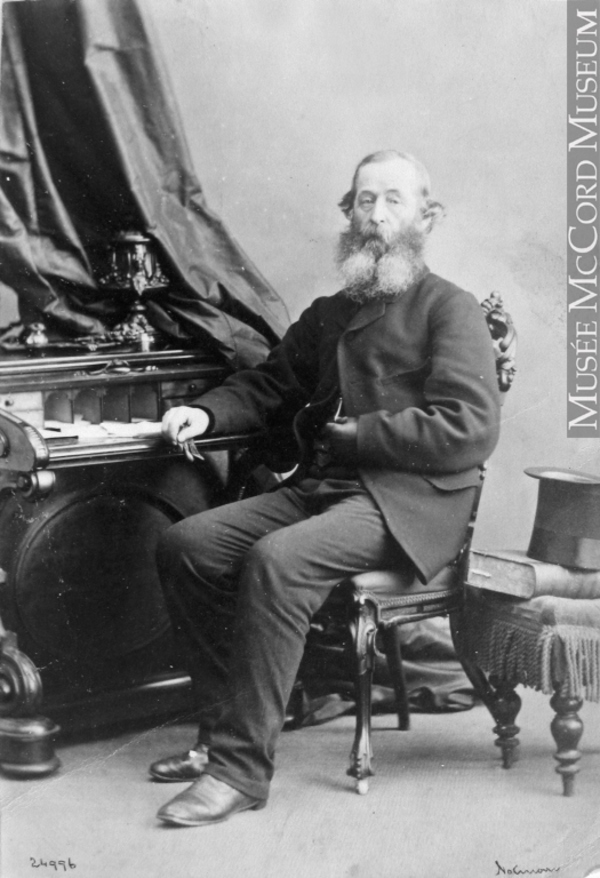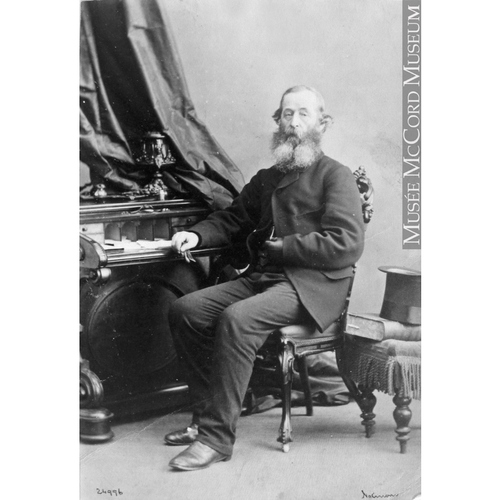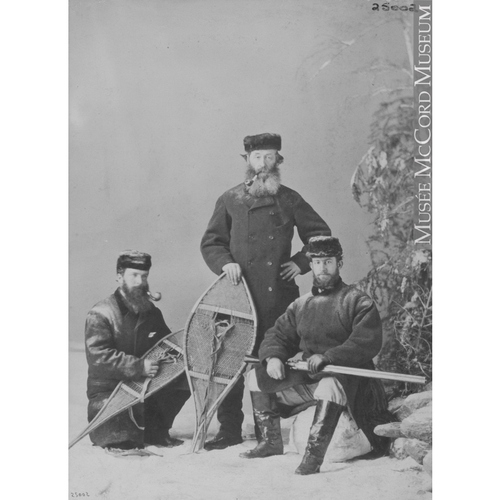
Source: Link
McKAY, SMITH, merchant, sealing captain, mineralogist, and politician; b. in 1817 at Pictou, N.S.; m. 14 Oct. 1869 Susan Lock, and they had one son; d. 8 Dec. 1889 at St John’s, Nfld.
Smith McKay arrived in St John’s from Pictou in July 1844 and in 1850 was a partner of McKay and McKenzie, St John’s general merchants and agents for the New York Mutual Life Assurance Company. In 1852 and 1853 McKay and McKenzie sent vessels to the seal-fishery and in the spring of the latter year Smith McKay acted as master of the sealing vessel Clara. In July 1853 he also is recorded as captain of the schooner Snipe which brought back several tons of oil after a successful hunt of humpback whales in St Mary’s Bay, but the partnership of McKay and McKenzie dissolved in that year and Daniel J. Henderson became McKay’s new partner. The firm was then known as McKay and Henderson. From February 1855 to July 1856 or later McKay was involved in salvage work around the Newfoundland coast and was authorized to recover the remains of the ship City of Philadelphia.
Probably through his friendship with Charles James Fox Bennett, McKay became interested in mineral exploration. In 1857 he was conducting a survey on the northwest shore of Notre Dame Bay, an area which geologist John William Dawson* believed should yield abundant copper and other ores, and discovered copper at Tilt Cove, the first considerable discovery in Newfoundland. Lacking the financial resources to begin a venture by himself, he formed a partnership with Bennett under the name Union Copper Mine and the first mine was officially opened on 9 Aug. 1864 with McKay as manager. Experienced miners, recruited in Cornwall, England, by the firm, formed the major part of the work-force, and high-grade, hand-cobbed ore from beds or sheets between 3 and 40 feet thick was shipped to the United States and Europe. What had been a fishing settlement with 10 or 12 shacks had become in the depressed year of 1868 “the only flourishing settlement in the island” with 700 to 800 men employed at the site. The value of exports from the mine had reached £1,000,000 by 1879, and Newfoundland had become the sixth largest copper producer in the world by 1880.
Between the years 1859 and 1881 McKay was granted several licences “to work mines and minerals” in the northwest part of Newfoundland, especially in the White Bay area, but nothing is known of his fortune in these ventures. He was also involved in other mining companies as both partner and salaried manager.
By 1877 trouble began to develop between McKay and Bennett in connection with the operation of the mine at Tilt Cove. Bennett filed a bill in the Supreme Court of Newfoundland preferring several charges against McKay, claiming in effect that McKay owed him £19,000. McKay counter-claimed, but the court ruled in favour of Bennett and in July 1880 he bought McKay’s interests in the mine for £45,000. Yet any wealth McKay accumulated through mining must have been quickly dissipated because in 1882 a certificate of insolvency and final discharge of his debts was granted by the Supreme Court of Newfoundland.
McKay and Bennett had also been partners in the political sphere. Supporting Bennett, McKay became one of the foremost figures in the vigorous anti-confederation election campaign of 1869. He ran successfully in Twillingate and Fogo where he had the definite advantage of being one of the major employers in the constituency. He was re-elected in 1873, 1882, and 1885.
In 1883 McKay was appointed to the politically sensitive position of chairman of the Board of Works by the prime minister, Sir William Vallance Whiteway*, and he held this position until his death. He had the delicate job of deciding on expenditures for local roads in the outports and in St John’s. Moreover, he was chairman through the contentious period prior to the incorporation of the city of St John’s in 1888 by colonial government edict; in this period the board was responsible for part of the city’s government including sanitation and McKay’s task was to prepare the city for the assumption of its own local administration. That McKay’s handling of these matters was generally acceptable is attested to by tributes in several St John’s newspapers at the time of his death.
Centre for Newfoundland Studies, Memorial Univ. of Newfoundland (St John’s), H. F. Foss, “History of Tilt Cove in the olden days” (typescript, 1966). Bennett v. McKay (1874–84), 6 Nfld. R. 178, 241, 462. Joseph Hatton and Moses Harvey, Newfoundland, the oldest British colony: its history, its present condition, and its prospects in the future (London, 1883). In re Smith McKay (1884–96), 7 Nfld. R. 44. Smith McKay and C. [J.] F. Bennett, Report no.21, Union Mine, Tilt Cove . . . (n.p., 1866). Daily Colonist (St John’s), 10 Dec. 1889. Evening Mercury, 9 Dec. 1889. Evening Telegram (St John’s), 4 Oct. 1883. Patriot (St John’s), 10 Jan. 1872. Public Ledger, 26 July, 31 Dec. 1850; 4 March 1851; March 1852; 8 March 1853. Royal Gazette (St John’s), 10 Dec. 1889. Telegraph (St John’s), 22 Dec. 1869. Times and General Commercial Gazette (St John’s), 30 Nov., 11 Dec. 1889. When was that? A chronological dictionary of important events in Newfoundland down to and including the year 1922 . . . , comp. H. M. Mosdell (St John’s, 1923). Who’s who in and from Newfoundland . . . (St John’s, 1927), 39.
Melvin Baker, “Origins of St. John’s municipal council, 1880–1888” (unpublished graduate paper, Memorial Univ. of Newfoundland, December 1974). Moses Harvey, “Copper, 1857,” Book of Nfld. (Smallwood), II: 342. J. K. Hiller, “Confederation defeated: the Newfoundland election of 1869” (unpublished paper presented to the CHA, 1976); “The railway and local politics in Newfoundland, 1870–1901” (unpublished paper presented to the Atlantic Canada Studies Conference, 1974). The old sealing days, comp. James Murphy (St John’s, 1971). T. [V.] Philbrook, Fisherman, logger, merchant, miner: social change and industrialism in three Newfoundland communities (St John’s, 1966). Prowse, Hist. of Nfld. (1895). A. K. Snelgrove and D. M. Baird, Mines and mineral resources of Newfoundland (St John’s, 1953). D. M. Baird, “Base metal deposits of the Buchans-Notre Dame Bay area, Newfoundland,” Geological Assoc. of Can., Proc. (Toronto), 8 (1956–57), pt.1 : 167–78. H. G. Donoghue et al., “Tilt Cove copper operation of the Maritimes Mining Corporation, Limited,” Canadian Mining and Metallurgical Bull. (Montreal), 52 (1959): 150–69. A. K. Snelgrove, “Geology and ore deposits of Betts Cove–Tilt Cove area, Notre Dame Bay, Newfoundland,” Canadian Mining and Metallurgical Bull., 24 (1931): 477–519.
Cite This Article
Calvin D. Evans, “McKAY, SMITH,” in Dictionary of Canadian Biography, vol. 11, University of Toronto/Université Laval, 2003–, accessed December 30, 2025, https://www.biographi.ca/en/bio/mckay_smith_11E.html.
The citation above shows the format for footnotes and endnotes according to the Chicago manual of style (16th edition). Information to be used in other citation formats:
| Permalink: | https://www.biographi.ca/en/bio/mckay_smith_11E.html |
| Author of Article: | Calvin D. Evans |
| Title of Article: | McKAY, SMITH |
| Publication Name: | Dictionary of Canadian Biography, vol. 11 |
| Publisher: | University of Toronto/Université Laval |
| Year of publication: | 1982 |
| Year of revision: | 2013 |
| Access Date: | December 30, 2025 |




